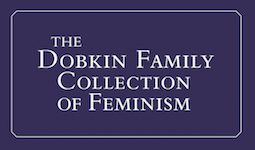Poetical Works.
Virginia Woolf’s Copy
[Woolf, Virginia]. Keats, John. The Poetical Works of John Keats. Edited with an introduction and textual notes by H. Buxton Forman. Oxford: Oxford University Press, 1906.
8vo.; portrait frontispiece, tissue guard; illustrated; endpapers lightly offset; brown cloth; paper spine label, lightly chipped.
A gift copy, inscribed on the front endpaper to Virginia Stephen by Violet Dickinson: A.V.S. from V.D. 1906. Woolf became an intimate friend of Dickinson (1865-1948) in 1902, writing to her at times in 1903 almost every other day letters addressed “My Beloved Woman,” detailing her father’s illness and her own feelings. By 1936, Dickinson had accumulated 350 letters from Woolf, most dating from this period. On April 28 Woolf wrote:
My Beloved Woman, Your letters come like balm on the heart. I really think I must do what I never have done—try to keep them. I’ve never kept a single letter all my life—but this romantic friendship ought to be preserved. …You remind me, all along, of Mrs. Carlyle. I am reading her too. Father says she’s the most wonderful letter writer in the language. She certainly has a strong likeness to my Violet—she gets into just the same queer places as you do—and has to do with exactly your queer kind of people.
In July she wrote of the “astonishing depths—hot volcano depths,” Dickinson had stirred in her, adding, “You have the art of saying things.” After her father’s death in 1904, Woolf convalesced from a nervous breakdown at Dickinson’s home, “where she made her first attempt at suicide by throwing herself from a window” (Hussey 72). In 1906 they traveled together, with Vanessa, to Greece, to meet with Adrian and Thoby Stephen.
After the return from that trip, a definite group began to form around the Stephen home in Bloomsbury—Vanessa married Clive, Virginia married Leonard—and though they kept in touch irregularly throughout their lives, they never revisited the intensity of those first years of the new century. But Woolf wrote in her diary of a visit paid in May 1919: “She hasn’t changed a hair for 20 years, which must be the length of our friendship. We take thins up precisely as we left them; a years gap makes no difference; we have had out intimacy; something or other has fused; & never hardens again. Thus I felt in talking to her; it was the usual inconsequent, generous minded, unselfish talk.” Dickinson is mentioned in the ironic preface to Orlando among the friends who helped Woolf “in ways too various to specify.”
Keatsian allusions, references, and themes can be seen throughout Woolf’s ouevre, but are especially pronounced in the earlier works, notably The Voyage Out, Jacob’s Room, and Mrs. Dalloway. Hussey discusses those found in A Room of One’s Own:
In A Room of One’s Own, Keats is first mentioned as one example of those self-conscious nineteenth-century male artists for whom writing was a struggle and who felt the world was indifferent to their work (AROO 51). Later, Woolf remarks that she would rather have the biography of a shop assistant than the seventieth study of “Keats and his use of Miltonic inversion” which “Professor Z” is at work on (AROO 90), appealing to her audience for something new in literary studies. Keats also appears in A Room as an example of the “androgynous” artists (AROO 103); Phyllis Rose believes that Woolf’s androgyny is very similar to Keats’s notion of “negative capability” (Rose 189).
Hussey also maps the trail of Keats as a Romantic poet in Woolfs other writing:
Woolf was very fond of the Romantic poets and often alludes to their work in her essays. Reviewing the Letters of Algernon Charles Swinburne for the Times Literary Supplement in 1918, she wrote that “no one would wish to sacrifice a line that Keats ever wrote; but we cling as firmly to some of his letters as to some of his poems” (E2 229). The “Supreme felicities” of Keats and Shelley, she wrote in 1919, “seem to come when the engin
Print Inquire

